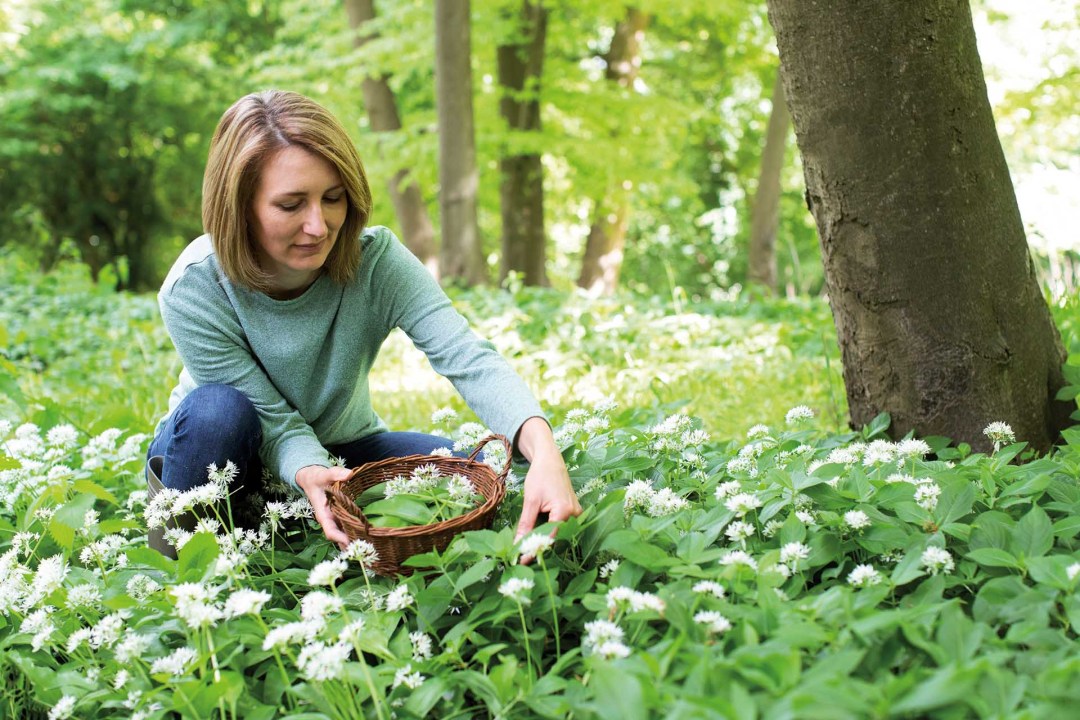Nature and wellbeing: the impact on your mental health
We explore the relationship between nature and wellbeing, and how getting closer to the earth can impact our mental health, while also learning new skills and increasing our knowledge of the natural world.

Feeling connected with nature has been proven to make us happier and healthier and one of the most effective and instant ways to boost that connection is to get your hands (or feet) dirty. From gardening to growing, foraging to bushcraft, Rebecca Frank explores the relationship between nature and wellbeing, and how getting closer to the earth can impact our mental health, while also learning new skills and increasing our knowledge of the natural world.
The gardener’s glow
I must confess that my gardening know-how extends little further than an appreciation of pretty flowers and a few strawberry bushes I once planted. However, if I can do something that will make me feel happier, learn something new and end up with some homegrown produce, I figure it’s time to up my game and start growing.
It turns out the gardener’s glow is about more than sunshine and physical activity (though they do play an important role). The hidden secret lies in the soil, and the serotonin-boosting bacteria it contains. Research shows that when we inhale the microbe M.Vaccae from soil it increases the levels of happiness hormones in much the same way as an anti-depressant.
It’s the combination of the soil bacteria and immersion in green space that make gardening a ‘high-quality nature’ experience, with benefits from reduced anxiety and depression to increased joy, calm, and creativity. On the rare occasions I do some weeding or planting I always wear gloves, mainly because I can’t be bothered to scrub my hands afterwards.
However, with my serotonin levels in mind and a tray of seedlings in hand, I discard the gloves and use my hands to lift the plants from the trays and press them into the earth. The soil is cold and wet, and there’s no denying that going glove-free makes for a more sensory experience. After I’ve finished planting a bed full of seeds and seedlings, I’m quite physically tired but also relaxed and my nails are full of soil but it’s strangely satisfying.
Studies show the antidepressant effect of the soil bacterium can last up to three weeks, so I figure a couple of hours in the garden is equivalent to a weekend yoga retreat – and a lot cheaper. I water my plants first thing every morning with the backdrop of birdsong and again in the early evening while pulling a few weeds and decompressing after a day at work. It’s satisfying to watch something growing slowly but surely and I’m resisting the temptation to plant more and risk overcrowding my bed. Patience it seems is a gardener’s secret weapon – and another lesson learned.
TRY THIS
When it comes to growing, Helen Rook, author of Urban Wild: 52 Ways to find Wildness on your Doorstep (Bloomsbury) advises to start by growing what you like to eat and, she says, you don’t need a garden or even a veg bed – an outside pot or window box will do. If you’re lacking space, she suggests growing small varieties such as a dwarf cherry tomato, mini-courgettes or short carrots. “If you prefer flowers they’re very rewarding too; dwarf multi-stemmed sunflowers will provide cut flowers for the house and dwarf nasturtiums brighten up any corner”. Whatever you choose to grow, Rook says to make a point to notice them growing. “Planting something and keeping it alive actually boosts your level of happiness,” she says.
The joy of foraging
With escalating food costs any produce we can grow at home or forage for is to be welcomed this year. Every spring our Somerset woodland is carpeted in wild garlic or ‘ramsons’ with its pungent green leaves that add flavour to risottos or stir-fries and make a delicious garlic butter. Wild garlic is pretty easy to spot due to its strong scent but if you’re foraging for edible plants, it’s always best to learn from an experienced guide or a very good book and I’ve gone for the former.
On a two-hour foraging walk I learn how to pick nettles for making soup and bread without getting stung (a firm grip) and learn how to tell a poisonous hemlock from abundant cow parsley. I pick and nibble at lots of little leaves with very different flavours and medicinal benefits – I will definitely be adding garlic mustard to a cheese sandwich and forget-me-nots to a summer salad.
It’s really enjoyable to wander at a slower pace, pause and observe the hedgerows that I normally walk past oblivious to the edible plants laid out before me. Studies show that the simple act of noticing nature is particularly effective in unlocking the mental health benefits and it’s all there waiting to be noticed, whether you’re in a park, woodland, or your back garden.
TRY THIS
Forage for some edible flowers and berries to decorate cakes, summer salads and cocktails. Look out for mallow with its pretty purple flowers, meadowsweet (found near water in marshes and ditches), wild strawberries, wild rose and nasturtium. For guidance, read the Hedgerow Apothecary Forager’s Handbook, a month-by-month guide to foraging with lots of ideas on how to make the most of your bounty.
Barefoot and carefree
If you’re not into growing or gathering you can reconnect with nature by simply taking your shoes off. Some experts say that walking barefoot (earthing or grounding as it’s known) can reconnect you to the earth’s subtle electric charge which we have lost through spending most of our time in buildings, our feet squeezed into a pair of shoes.
Evidence suggests that if we increase our barefoot contact, it can help with chronic pain, boost immunity, improve sleep and reduce stress. I take off my shoes in the garden and think about how rarely I do this apart from on holiday. The feel of the grass underfoot reminds me of doing handstands and cartwheels and having constantly muddy feet as a child. It’s a pleasant sensation and I wiggle my toes enjoying the waves of nostalgia.
Helen Rook recommends walking on different textures such as soft moss and rough pebbles. “It’s not important whether you walk fast or slow, travel ten metres or ten miles; it’s about enjoyment not endurance and all that matters is that your feet are in contact with the ground.”
TRY THIS
Picnics are a great way to enjoy getting closer to nature and gather with friends and family, not least because you don’t have to clear up the kitchen afterwards. If the grass is dry, ditch the picnic blanket, take off your shoes and enjoy the feeling of the grass and earth on your skin noticing how it supports you. Why not make a daisy chain or lie back and just watch the clouds for a while?
Earth mother
When I first moved from London to Somerset, I was keen to immerse my kids in the natural world I felt we had been missing out on. One of my first outings with my 3-year-old son was to a local woodland activity centre, Hidden Woods. We built dens, learned some basic bushcraft skills and toasted marshmallows over a campfire. I clearly remember all the kids crowding round the ‘mud kitchen’ where cakes and sandwiches were moulded from dirt and presented with grubby fingers and big proud smiles (who needs Play-Doh?).
My toddler is almost as tall as me now, but we still spend a lot of time in the woods and during lockdown it was where we walked and talked each day. It’s no coincidence that being among trees makes us feel better – essential oils (phytoncides) released by trees and plants have been shown in Japanese studies to reduce stress, depression and anger as well as improving immune function.
A common activity in Japan, this form of woodland aromatherapy known as Shinrin-yoku or forest-bathing, is becoming increasingly popular around the world. To really absorb the sounds, smells and sights of nature, you need to pause and switch on your senses.
Next time I’m out walking the dog I find a log in the woods, in a clearing where the sun filters through the tree canopy and sit a while. I spend a few minutes looking down at the forest floor and then upwards at the trees, touching the bark and picking some up off the ground nearby. After a while I hear children running towards me, gathering sticks to make dens, their hands and knees caked in dirt. I think to myself, it’s no wonder they laugh around 300 times a day compared with 15-30 for adults.
TRY THIS
Find a sit-spot – somewhere you can sit or lie for a while amongst the trees in a wood or park or garden and soak up your surroundings. Observe the sights and sounds in your immediate area. Who are you sharing this space with? Focus only on what is right here, right now.
READ MORE
The power of touch: the benefits of physical contact






